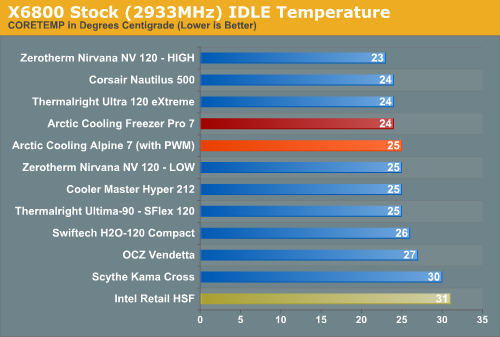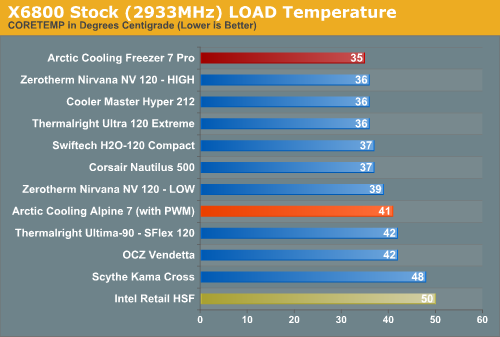Arctic Cooling Duo: Alpine 7 & Freezer 7 Pro Attack Value
by Wesley Fink on January 29, 2008 2:00 AM EST- Posted in
- Cases/Cooling/PSUs
Cooling at Stock Speed
Some users will never overclock their CPU, but they still want to run the coolest CPU temperatures possible to enhance stability and extend CPU life. We compile all temperature benchmarks with CoreTemp, a public domain utility that is quite stable with reproducible results on the Intel platform. This required retesting a cross-section of the best coolers evaluated so far at AnandTech. To better document performance in the large speed gap between 2.93 GHz and 3.73 GHz, we added the intermediate value of 3.33 GHz to all test results during the retest of the coolers.

Performance at stock idle is amazing for the Alpine 7 - a cooler that costs less than $15. The Freezer 7 Pro does slightly better, but both perform much better than you might expect at this price point. Where the very good Intel stock air-cooler keeps the X6800 at 31C at idle, the Alpine 7 reduces that to 25C and the Freezer 7 Pro is one degree lower at 24C. This compares to the top Thermalright Ultra 120 eXtreme at 24C, Corsair water-cooling at 24C, Swiftech water-cooling at 27C, and ZEROtherm Nirvana at 23C. In comparing results, please keep in mind the test results from the new cooling bed using CoreTemp are not directly comparable to earlier cooling results.
It is more difficult to simulate all the various stress conditions a computer may encounter in different operating environments. For most home users, contemporary gaming is one of the most demanding CPU (and system) applications. Therefore, our stress test simulates running a demanding contemporary game. We loop the Far Cry River demo for 30 minutes and capture the CPU temperature with CoreTemp's "logging" option. We report the highest temperature during the load test. We ignore momentary spikes and report a sustained high-level temperature that you are likely to encounter in this type of scenario. This test configuration roughly equates to an 80% CPU load test using Intel TAT, another respected program for thermal measurements.
We next compare cooling efficiency of the Arctic Cooling HSFs under load conditions at stock speed to the retail HSF and other recently retested CPU coolers.

The Freezer 7 Pro turns in an outstanding performance under load at stock speeds. CoreTemp results are 35C, which is one of the best air-cooling results tested so far at AnandTech. The Alpine 7 is also a terrific performer under load at 40C. This sub-$15 cooler is a significant improvement over the stock Intel fan, which reaches 50C under load at stock speed in our cooling test bed.
If you do not plan to push overclocking to the extreme, the Freezer 7 Pro is an outstanding choice. The stock performance at idle and load is among the best we have tested - matching or coming in a bit better than the Thermalright Ultra 120 eXtreme. The Alpine 7 is frankly cheap to buy, but it still significantly outperforms the stock Intel cooler at stock speeds. These reasonably priced coolers from Arctic Cooling are great choices if you want better cooling at standard CPU speeds.










48 Comments
View All Comments
Etern205 - Tuesday, January 29, 2008 - link
Sorry for the triple post.Somehow the link code does not work so...
http://www.intel.com/cd/channel/reseller/emea/eng/...">http://www.intel.com/cd/channel/reselle...essors/c...
strikeback03 - Wednesday, January 30, 2008 - link
Great, an LED fan direct from Intel.and it still uses push pins, though since it weighs about the same as the previous stock cooler I guess that is expected.
sparkuss - Tuesday, January 29, 2008 - link
Is there any reason you don't include with the new testbed/database your custom water cooling setup that you've been using to chart the X38/X48?I realize it may be extreme but it feels missing if only to show what that "next" level of cooling means in relation to the "top rated performers". I guess I'd also be remiss in not asking for at least one of the new Peltier/Water compact combo coolers in the mix just for those reference lines on the graphs.
If you only want to limit results to "available/ready to buy" I understand.
I'm still looking at all options for my next "technology-leap" (AMD 4000+ 939) system build and being able to see if investing in the extreme is worth the results would help with some of the choices.
Thanks
strikeback03 - Wednesday, January 30, 2008 - link
I'd guess Wesley is in a different part of the country/world than Raja or whoever has the extreme cooling setup.mindless1 - Tuesday, January 29, 2008 - link
Quote:"low noise, longer-life fan bearings and elastomeric fan mounts. This is expensive engineering."These aren't really longer-life bearings. Anyone can make a bearing and claim that in an ideal environment it will have really long life. That's shady marketing, the finished fan, as implemented, is not that ideal environment for several reasons such as thrust level, imbalance, ambient temp. Frankly I find the bearing on my Freezer 64 Pro to be below average compared to my major (fan manufacturer not PC parts relabeler) brands. I would rate them as well if not better than many of the crude fans one would find on cheap heatsinks at least, and the fan imbalance being offset by the rubber mounts does help.
As for the elastomeric fan mounts, no this is not expensive engineering. Maybe a penny a piece, no more expensive than screws to hold a fan on. Perhaps we could say the unique fan frame design cost a slight bit extra though when in volume the cost may be less than you'd think, particularly if not manufactured by a major label. Upon examination of the fan bearing anyone with a trained eye can easily see these are not premium sleeve bearings by any stretch, and they are a lot short on lubricant, you should expect them not to be so quiet within the life of the system. Relube the bearing periodically for best results.
While my comments seem (are) negative, overall these coolers are a great value, but we do need to be objective in recognizing the cons as well as the pros. I'm not aware of better value for the money so they are still 'sinks to seriously consider except for attempts at extreme overclocking.
Wesley Fink - Tuesday, January 29, 2008 - link
The Engineering is expensive - not necessarily the parts. What we were trying to say here is that these kinds of solutions are usually reserved for higher-priced coolers, and not often seen on coolers selling for such a low price.As for bearing life, most coolers in this price range don't even rate fan bearing life. The expected "life" of the fan on the under $15 Alpine 7 is 400,000 hours and the bearing is a Fluid Dynamic Bearing - like the Scythe Sflex 120mm fan which is $20 for the fan alone. These are both impressive specs for any cooler fan - especially one that sells with the complete cooler for less than $15.
mindless1 - Tuesday, January 29, 2008 - link
The life rating of 400K hours is nonsense.Their typical fan sells for $6, and that with a bit of profit built in. Their bearings are not special, just the marketing is.
http://www.newegg.com/Product/Product.aspx?Item=N8...">http://www.newegg.com/Product/Product.aspx?Item=N8...
A minimum price is a better proof than an inflated one, as even the generic junk out there selling for $2 is also marked up 250% or more through relabelers.
forgotmypassword - Tuesday, January 29, 2008 - link
Your under load test is WAY TOO GENTLE. Same AC Freezer 7 can hardly keep my E6550 @ 2.8GHz Core Duo under 75C under 100% load... Compare it to your 41CRamarC - Tuesday, January 29, 2008 - link
if your e6550 is hitting 75c you either don't have the freezer 7 mounted properly or your bios/fan control is configured to allow that level of heat.mindless1 - Tuesday, January 29, 2008 - link
You have no evidence of that. A higher ambient temp, worse case ventilation, and/or higher vcore can cause this.However, some mountings don't seem to put as much pressure on the 'sink, it can be mounted as "properly" as possible and still this (and especially along with a combination of aforementioned factors) could result in that temp.
The real question is WHY someone would have allowed their CPU to get this hot instead of reducing the o'c or taking whatever other measures are necessary.